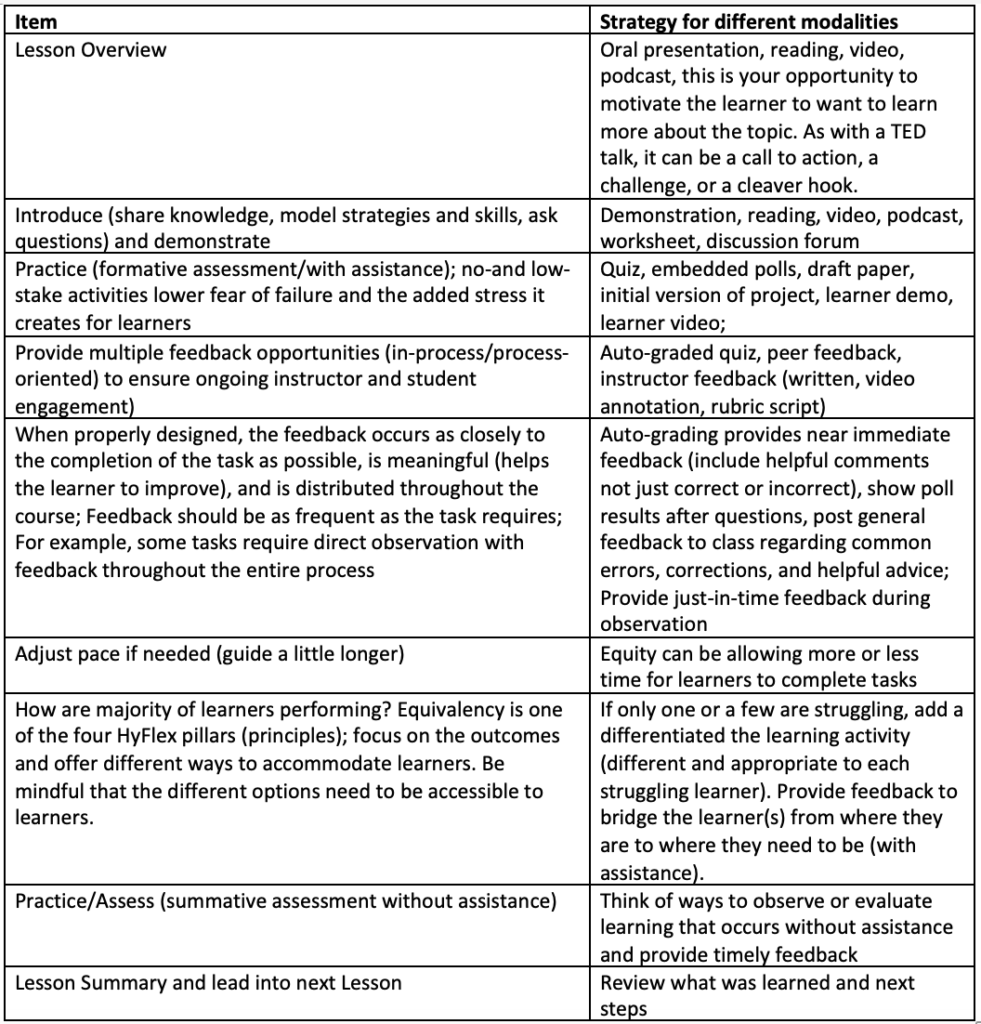 Co-Author Glori Hinck
Co-Author Glori Hinck
HyFlex delivery may be new to many learners. Therefore, it is important to provide them with the supports they need to be successful. Regardless of the delivery mode, learners are motivated by success and by instructor presence. In part one of this topic post, we will write about how instructor support and feedback (a form of guidance) can motivate learners and build learner confidence.
Feedback is a form of presence that we will discuss more in part II of this post. Efficacy is developed by gradually decreasing instructor support, including feedback, until learners are responsible for their own learning. Concurrently, learning often increases in complexity or difficulty. Scaffolding is used to support learners as they build their knowledge and skill and is particularly important if they are new to HyFlex delivery. During the scaffolding process, you are building competence and confidence. Learning is an iterative process (think soak, wash, rinse, and repeat) built on the model of show me, let me try, assess me. A variation is I do, we do, you do . Whichever is your primary delivery mode, it is often the one you are most comfortable delivering and for which you have the most activities and assessments. Offering equivalent experiences can be a challenge for HyFlex designers and instructors. For example, how can you best improve communication across delivery modes, and at the same time, scaffold the learning? Perhaps you can provide feedback preemptively. Create and maintain an FAQ that all learners can reference. Another tip is to provide references and resources in the rubrics you provide.
The learning process is designed to aid learners in connecting prior knowledge and experience to new. The space between what we know or can do and what we want to be able to know or do is called the Zone of Proximal Development (ZPD), a theory attributed to Len Vygotsky. Later, Jerome Bruner applied the ZPD to an education setting with the concept of scaffolding mentioned in the opening of this post. You may view a short video about ZPD on YouTube by clicking on the following link: https://youtu.be/y3HOLXdvtaE.
Educators use gamification to motivate learners. Gamification is foundationally, self-efficacy along with self-determination theory and flow theory. Gamification is a strategy for introducing game elements into non-game environments . In other words, gamification may be used to keep learners motivated to move from where they are to where they need to go. The reasons learners fail to progress include the amount of challenge, the number of choice options, and fear of failure. There are many more reasons learners stop working or drop from a course. However, we will not focus on those today. Today we will look primarily at learner support to develop learner confidence and motivate learners.
Several analogies can be used to illustrate the ZPD concepts. I once had a mentor who shared the analogy of rock climbing. Learners need mechanisms to hang on to (old information) to progress (connect to new information).

Learners need mechanisms to hang on to.
This Photo by Unknown Author is licensed under CC BY
Or, think of how you learned to ride a bike. You likely started with 4-wheels subsequently progressing through 3-wheels to 2-wheels with training support and finally mastered riding a 2-wheel bike. And lastly, think about how the danger is removed from learning the high wire through use of a safety net. Your students need this same safety net as you scaffold their learning.Below is a sample lecture structure with some strategy ideas per multiple delivery modes.
Sample Lesson Structure to guide and support learners

Feedback is one scaffolding strategy. What other ideas do you have for efficiently scaffolding the HyFlex learning experience for your students or for providing feedback? Share your thoughts and ideas in the comments. In our next post we will dive more deeply into using feedback to improve student success and satisfaction.
Notes:
i https://www.buffalo.edu/ubcei/enhance/teaching/guiding-students/scaffolding.html
ii https://youtu.be/y3HOLXdvtaE
iii https://files.eric.ed.gov/fulltext/ED607091.pdf
Author
-

Recently retired from the LCTCS. Served as the Dean of Global Online at Fletcher TCC and Dean of DLIT at Delgado CC. Is a HyFlex Learning Community Advisor and a freelance ID.
View all posts
[…] Part I – Motivating Learners by Building Efficacy (Confidence) through Scaffolding and Support— from hyflexlearning.org by Jeanne Samuel […]